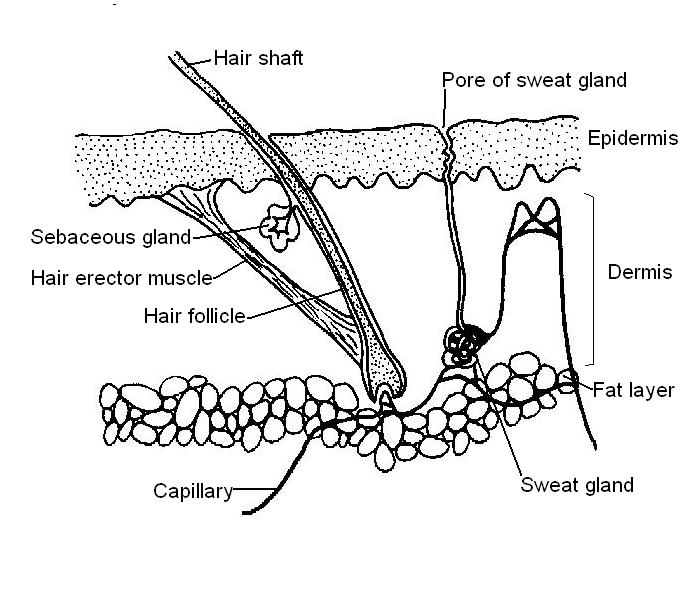The Anatomy and Physiology of Animals/Skin Worksheet/Worksheet Answers
1. The outermost layer of the skin is: the epidermis
2. Which is the thickest layer: the dermis
3. Add labels to the diagram of the skin shown below.
4. Which of the following happens to epidermal cells as they move up to the surface of the skin?
- Keratin is deposited in them / they become flattened and scale-like / they die / they become thicker / they become more active / they are shed from the surface / fat is deposited in them / they grow hairs
5. Keratin deposited in the epidermal cells: makes it waterproof / kills the cells.
6. Which of the following is NOT a keratin skin structure:
- antlers
7. The function of melanin in the skin is to: protect underlying layers from the harmful rays of the sun
8. The hair erector muscle: gives humans goose bumps / makes animals hair stand on end
9. Sebaceous glands secrete: oils
10. Sweat glands are: exocrine glands
11. Sense organs for touch, pressure, pain and temperature are found in the:
- dermis?
12. All vertebrates are homoiothermic (warm blooded) animals. False Only mammals and birds can control their body temperature. ie they are warm blooded or homoiothermic.
13. Temperature regulation is under the control of the: hypothalamus
14. Which of the following are NOT important in temperature regulation of the body: sebaceous glands produce oil for waterproofing and protecting the hairs
15. Which vitamin is produced in the skin in sunlight? Vitamin D
16. Large animals find it easier to keep warm than small ones because: the ratio of the outside body surface area to the inner body volume is smaller
17. Which of the following is NOT a function of the skin: holding in the organs
18. Frogs and other amphibians use their skin for: gas exchange attracting a mate.
19. Match the skin structure with its function.
| Structure | Function |
|---|---|
| A. Epidermis | f. Protection from infection |
| B. Hair erector muscle | g. Makes hairs stand on end |
| C. Fat cells | a. Insulation |
| D. Sebaceous gland | h. Secretes oily substance to coat hairs |
| E. Dermis | i. Makes skin tough |
| F. Melanin | c.Protection from sun's rays |
| G. Hair | d.Heat retention |
| H. Sweat gland | e. Heat loss |
| I. Blood capillaries in the dermis | j. Constrict or dilate to control heat loss |
| J. Keratin | b. Water proofing |
